Meat Pie: Basic Information
Pronunciation
Alternative Name(s)
Dish Type
Course
Mealtime
Popular Meat Pie Variations

Old-fashioned Meat Pie

Steak and Guinness Pie

Scotch Pie

Cornish Pasty

Steak Pie

Mince Pie
Meat Pie: Ingredients and Preparation
Main Ingredients
Main Cooking Method
Preparation Process
Meat Pie: A Deep Dive
Cultural Significance
Taste
Texture
Aroma
Color
Serving Style
Serving Temperature
Accompaniment
Occasions
Seasons
Special Diets
Calories
Popularity
Popular Similar Dishes
- Empanada
- Börek
- Calzone
- Chebureki
Popular Dining Area
Meat pie is a type of savory pie consisting of a flaky crust and a filling of minced meat or similarly savory ingredients.
A popular dish in many cuisines worldwide, it dates back to the New Stone Age, with many subsequent recipes appearing in ancient Egypt, Greece, and Rome.
People usually bake meat pies in the oven, but frying in oil, air-frying, and microwaving are also popular techniques.
In addition, it is also possible to bake meat pies without an oven by brushing the bottom of a stainless steel pot with some butter or oil, placing a trivet or metal steaming rack in the pot, putting the pies on it, and cooking with the lid on.
Since meat pies are usually rich and savory, they go well with vegetable-based sides like mashed potatoes, creamed spinach, roasted vegetables, mushy peas, etc.
Certain sauces and gravies, like tomato sauce, mushroom gravy, and onion gravy, are also excellent accompaniments for meat pies.
There are many other interesting facts about meat pies, such as their origin, main ingredients, famous regional varieties, and pros and cons.
Read on, and you will learn about them, as well as what questions people usually ask about meat pies and dishes similar to them.
Key Points
What Is the Origin of Meat Pies?
Ancient Egyptians created some of the world’s first meat pies, which spread to Europe and played an important role in the old continent’s cuisine. Many modern meat pie recipes have European origins.
The medieval version of meat pie had a thick, bland, and almost inedible crust. The modern interpretation, with a flaky and delicious butter-enriched crust, only emerged in the 15th century thanks to bakers in France and Italy.
European-style meat pies were spread all over the world during the colonial period, developing into countless varieties in the Americas, Africa, Asia, and Oceania. Several types of non-European pastries are also considered meat pies, such as sfiha in the Middle East.
The evolution of meat pies has a noticeable effect on the many aspects of the dish, especially the main ingredients.
What Are Meat Pies Made of?
To make meat pies, people usually employ the following 4 ingredients:
| Ingredients | Characteristics |
|---|---|
| Crust | Shortcrust pastry, flaky puff pastry, filo (phyllo) pastry, suet crust, American-style crust, cornmeal crust, bread dough, etc. |
| Meat | Ground beef, pork, lamb, chicken, rabbit meat, kidneys, etc. |
| Vegetables | Potatoes, onions, carrots, tomatoes, swede (rutabaga), peas, etc. |
| Spices | Cloves, cinnamon, allspice, etc. |
Besides those ingredients, additional components like gravy, hard-boiled eggs, or bread are vital to the deliciousness of famous meat pie variations in many regions around the world.
What Are Well-known Regional Variations of Meat Pies?
Below are the 36 most famous types of meat pies worldwide:

Old-fashioned Meat Pie
Origin: Global
Key Ingredients: Pastry, ground meat, vegetables

Steak and Guinness Pie
Origin: Ireland
Key Ingredients: Puff pastry, steak, Guinness stout, vegetables
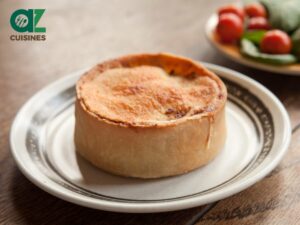
Scotch Pie
Origin: Scotland
Key Ingredients: Hot water crust pastry, beef or lamb

Cornish Pasty
Origin: Cornwall, England
Key Ingredients: Shortcrust pastry, beef, potatoes, swedes, onions
- Crimped pastry edge
- Filled with at least 12.5% beef and 25% vegetables

Steak Pie
Origin: United Kingdom
Key Ingredients: Pastry, steak, beef gravy

Mince Pie
Origin: England
Key Ingredients: Pastry, mincemeat (a mixture of fruits, citrus, nuts, spices, and suet)

Chicken and Mushroom Pie
Origin: Great Britain
Key Ingredients: Puff pastry, chicken, mushrooms, cream of chicken

Shepherd’s Pie or Cottage Pie
Origin: Britain and France
Key Ingredients: Minced lamb or beef, mashed potato

Tourtière
Origin: Quebec, Canada
Key Ingredients: Pastry, minced meat, potatoes
- French-Canadian meat pie
- Usually served on Christmas and New Year’s Eve

Coulibiac
Origin: Russia
Key Ingredients: Brioche or puff pastry, salmon or sturgeon, rice or buckwheat, mushrooms, hard-boiled eggs, onions

Kreatopita
Origin: Greece
Key Ingredients: Filo pastry, ground meat, feta cheese, onions

Lihapiirakka
Origin: Finland
Key Ingredients: Doughnut dough, minced meat, rice or mashed potatoes

Empanada
Origin: Spain
Key Ingredients: Various fillings (meat, cheese, vegetables), pastry

Pirozhki
Origin: Russia
Key Ingredients: Yeast dough, various fillings (meat, vegetables, or fruits)

Australian and New Zealand Meat Pie
Origin: Australia and New Zealand
Key Ingredients: Pastry, minced meat, gravy
- Hand-sized pie filled with minced meat and gravy
- Served as a takeaway snack
- Considered one of the national dishes of Australia and New Zealand

Flipper Pie
Origin: Newfoundland and Labrador, Canada
Key Ingredients: Pastry, harp seal flippers, vegetables (such as onions)

Rabbit Pie
Origin: Great Britain, United States, Australia
Key Ingredients: Pastry, rabbit, vegetables (onions, carrots, celery, etc.), broth
- Can be made with other types of meat (such as bacon and chicken)
- Usually contain wild rabbit meat

Sea Pie
Origin: United States, Canada
Key Ingredients: Pastry, various types of meat or fish (pork, veal, beef, tuna, etc.), vegetables (especially onions)
- A traditional pie dating back to the colonial period
- Originally served to British sailors

Pot Pie
Origin: North America
Key Ingredients: Pastry, meat like chicken or beef, vegetables, gravy
- Derived from English pies
- Made with a top crust and a filling of meat and vegetables in gravy
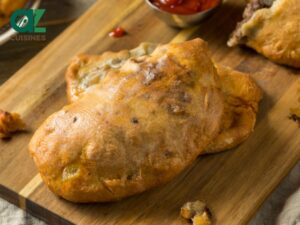
Michigan Pasty
Origin: Michigan, USA
Key Ingredients: Pastry, beef, potatoes, onions, rutabaga
- A side-crimped pie derived from Cornish pasties
- Filled with meat and vegetables

Natchitoches Meat Pie
Origin: Louisiana, USA
Key Ingredients: Pie shell, ground beef or pork, peppers, garlic
- Crescent-shaped savory pie
- Deep-fried in peanut oil

Ghanaian Meat Pie
Origin: Ghana
Key Ingredients: Pastry, ground meat, onions

Nigerian Meat Pie
Origin: Nigeria
Key Ingredients: Pastry, minced beef, potatoes, carrots, onions, beef broth
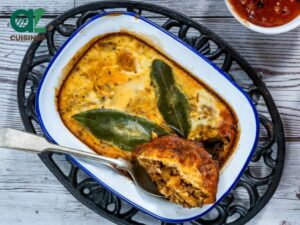
Bobotie
Origin: South Africa
Key Ingredients: Bread, minced meat, eggs, milk, vegetables, dried fruits.

Pastilla
Origin: Morocco
Key Ingredients: Warqa pastry (brick pastry), chicken or seafood, eggs onions, almonds, dried fruits
- Moroccan pie combining sweet and savory flavors
- Has a crispy crust

Jamaican Beef Patty
Origin: Jamaica
Key Ingredients: Pastry, curry powder, ground beef, vegetables, broth

Xian Bing
Origin: China
Key Ingredients: Pastry, ground meat, onions, Chinese condiments

Jinyun Shaobing
Origin: Zhejiang, China
Key Ingredients: Yeast dough, pork, dried vegetables, maltose syrup

Salteña
Origin: Bolivia
Key Ingredients: Pastry, minced meat, vegetables, gelatin, broth.

Fatayer
Origin: Middle East
Key Ingredients: Pastry, onions, and filling ingredients like spinach, meat or cheese.
- Middle Eastern pie
- Often shaped like a boat or triangle

Sfiha
Origin: Lebanon, Syria
Key Ingredients: Flatbread, minced lamb or beef, pine nuts
- Open-faced meat pie
- Made by topping flatbread with cooked minced meat

Ichlekli
Origin: Turkmenistan
Key Ingredients: Flour, butter, meat (beef or lamb), and vegetables
- Turkmen shepherd’s pie
- Considered the unofficial national dish of Turkmenistan
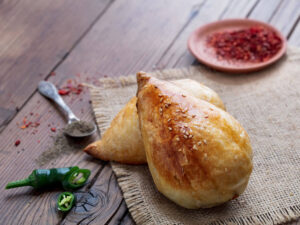

Samosa
Origin: South Asia
Key Ingredients: Pastry and filling ingredients like ground meat, vegetables, or cheese
- Fried pastry derived from neighboring cuisines
- Served as an entree, snack, and side dish
- Popular in India and Pakistan

Curry Puff
Origin: Southeast Asia
Key Ingredients: Puff pastry, curried meat, potatoes
- Deep-fried or baked pastry puff with a curry-flavored filling
- Popular in Singapore, Malaysia, Thailand, and Brunei

Bánh Pâté Chaud
#127
in Vietnam
Origin: Vietnam
Key Ingredients: Meat (pork, chicken, or beef), pâté, all-purpose flour
These varieties contain many standard failings and strong points of regular meat pies.
Pros and Cons of Eating Meat Pies
Pros
Cons
After learning about those pros and cons, let’s deepen your knowledge of meat pies by checking out common concerns about them.





























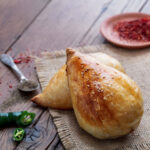






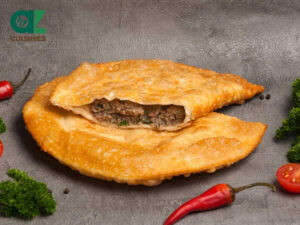
Adam Sam
Senior Food and Drink Editor
Expertise
Food Writer & Recipe Developer, Recipe Tester, Bartender, Cooking-video Maker, Editor In Chief
Education
Adam Sam, an experienced food writer and recipe developer, is passionate about blending diverse culinary traditions, national dishes, and innovative beverages, showcasing his proficiency in both traditional and modern recipe testing.
As the Editor-in-Chief, he elevates culinary content from street food to fine dining, focusing on Western cuisine and types of drinks at azcuisines.com, and is professional in creating engaging cooking videos that simplify complex dishes and ingredients.
His passion for food is evident in his writing, where he uniquely merges various cultures, traditions, and contemporary trends, skillfully combining classic recipes with modern cooking methods.